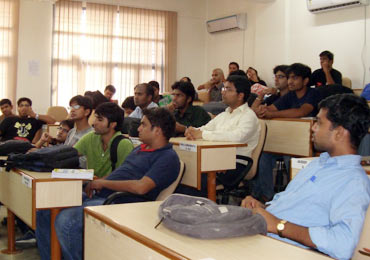 | « Back to article | Print this article |
Here's what is wrong with most B-schools in India!
He runs a popular preparatory school in Delhi for admission tests like MAT (management aptitude test) and CAT (common admission test) to business schools.
In the last few months, he has been inundated with calls from business schools from across the country to send his students directly to them; some of them are ready to pay him up to Rs 100,000 per student for the favour.
This is illegal -- that's perhaps why he, a South Indian is his mid-30s, does not wish himself and his school to be named -- because no business school can admit students who haven't taken CAT, MAT or GMAT (Graduate Management Admission Test) or any other qualifying state examination.
Not willing to get on the wrong side of the law, he has ignored all such overtures, though a hundred students could have made him richer by Rs 1 crore (Rs 10 million).
But he knows business schools are desperate; anybody less scrupulous could have made a killing. He recently fired some employees who, for a bribe, had begun to liaise with his students on behalf of the business schools.
Click NEXT to read on . . .
Here's what is wrong with most B-schools in India!
Singh, who wants to be identified only by his surname, runs a preparatory school in Bengaluru. His narrative is no different. Singh has been flooded with 'gifts' from business schools who want his students.
Three years ago, not more than four or five business schools came up with such offers, that too discreetly. Now, the count has gone up to over a hundred, and many of them are not averse to making the indecent proposal by email.
There are at present 10 large preparatory schools that operate close to 4,000 branches; ask any one of them and you will hear the same story. For the business schools, the logic is quite straightforward: Whatever is paid to people like Singh, they will recover from the hapless students in fees.
The chairman of an East-based business school recently found some ex-students hanging around his gate. Sensing something fishy in their body language, he had them rounded up.
He found out, to his chagrin, that a rival business school had paid these boys to badmouth his business school and lure his students away to the rival. For every student who came to the rival, a certain amount was guaranteed; if the visit resulted in admission, a bonus was on offer!
Click NEXT to read on . . .
Here's what is wrong with most B-schools in India!
The scary truth of business education, which not so long ago was a passport to a cushy corporate job, is finally out -- there just aren't enough takers.
There are, at last count, over 3,000 business schools in India. Apart from the top 25 or so, which includes the prestigious Indian Institutes of Management, Indian School of Business and a handful of others, most others are struggling to fill their seats.
There are about 300,000 business school seats in the country. Last year, around 60,000, reckon sector experts, went vacant; this year, the expectations are the number will cross 70,000.
A crisis faces the country's second- and third-rung business schools. The sector is abuzz with the talk that some have decided to down shutters.
Low entry barriers have resulted in business schools popping up all over the country. Several are little more than holes in the wall.
Click NEXT to read on . . .
Here's what is wrong with most B-schools in India!
Drive along highways and you will find ornate business schools in the middle of paddy fields and next to cowsheds. A sweetmeat seller in Punjab has opened one; several political upstarts in Uttar Pradesh run their business schools in the remotest parts of the state.
A business school can be started with 20,000 square feet of built-up area, seven faculty members, 20 computers, 2,000 books and subscription to 30 journals. If you already own the land, your investment could be less than a crore (Rs 10 million).
Standalone business schools are regulated by the All-India Council for Technical Education (AICTE) and those that are a part of universities by the University Grants Commission. AICTE says its job is to create the capacity for business education with the right infrastructure; that's why it has allowed new business schools to come up, provided they meet the laid-down requirements.
Thus, almost 100,000 business school seats were created in 2008, when the job market was on fire. Since then, the market has slowed down but another 80,000 seats got added in 2010.
Click NEXT to read on . . .
Here's what is wrong with most B-schools in India!
Three thousand business schools with 300,000 seats may look small in a country of 1.2 billion people but it is way beyond the absorptive capacity of its corporations.
While students who pass out of top business schools get packages of Rs 8 lakh (Rs 800,000) per annum and above, those from Tier-II and Tier-III business schools get offers of as low as Rs 1.5 lakh (Rs 150,000) per annum.
Now look at it from the other end of the funnel. The average fee of a two-year MBA programme in a business school is Rs 6 lakh (Rs 600,000).
An education loan of this amount, at an interest of 12 per cent and tenure of five years years, means a monthly installment of Rs 13,346 -- something a salary of Rs 1.5 lakh per annum just cannot support. This has caused disillusionment with business education amongst the young.
Click NEXT to read on . . .
Here's what is wrong with most B-schools in India!
Suniel Mulla, who completed his MBA in human resource management from a business school in Lucknow, is working at a call centre for Rs 3 lakh (Rs 300,000) per annum after paying Rs 6 lakh for the course.
Mulla is not sure if the MBA degree on his curriculum vitae has been of much help -- he could have got the same job without investing two years of his life and Rs 6 lakh. The return on his investment, Mulla knows, is poor.
His is not an isolated case. D Samrath, who graduated in international business management from the Pondicherry University in 2009, is also working in the call centre of a global outsourcing outfit.
Though he paid less, Rs 70,000, for his degree, he too gets Rs 3 lakh as annual salary. Though Samrath's RoI is better, he is disillusioned. The high-profile job he had dreamt of remains just a dream.
People like Mulla and Samrath are bad ambassadors for business education. Their plight, which they recount in full detail in their peer groups, has deflated the enthusiasm for business education.
Click NEXT to read on . . .
Here's what is wrong with most B-schools in India!
Some BTech students at the NIIT University at Neemrana in Rajasthan, in an interaction with Business Standard, say candidly that they would prefer to do an MTech after graduation than an MBA degree because of better employment prospects.
"Even the top business schools," a second-year student says, "manage just 70-80 per cent placement."
The disenchantment is showing up in other ways too. In 2009, 300,000 young men and women had appeared in MAT. The number fell by a third to 200,000 in 2010.
The much-in-demand CAT, the qualifying examination for the IIMs and over 150 other business schools in the country, is also being cold-shouldered by the youngsters -- in 2009, 241,000 took the exam; in 2010, their numbers fell to 206,000.
Click NEXT to read on . . .
Here's what is wrong with most B-schools in India!
No wonder, business schools are sending out undisguised messages to the preparatory schools.
Human resource managers in companies complain that the stock churned out by most business schools is unemployable. The faculty, they allege, is made up of fresh graduates who have not worked with industry at all.
Worse, only a handful has interaction of any kind with industry. As a result, what the students are taught is of little practical relevance.
Companies lament that apart from the salaries of the fresh graduates, they are required to invest large sums of money in their retraining and supervision, and this throws the economics of hiring them totally out of whack.
Click NEXT to read on . . .
Here's what is wrong with most B-schools in India!
There is no assessment of the rot. But some idea can be had from a survey published last year by Aspiring Minds which showed that employability of engineering graduates was as low as 4.22 per cent for IT product companies and 17.84 per cent for IT service companies.
KPOs, the survey said, will find only 9.47 per cent graduates employable and BPOs 38.23 per cent. Thus, 61.77 per cent students require training in both soft-skills and problem-solving skills to be eligible for any job in the IT and IT-enabled service sectors.
The situation in Tier-II and Tier-III business schools, most agree, is no different.
Krishna Tanuku, the executive director of Indian School of Business' Centre for Entrepreneurship, has liaised with several Tier-II and Tier-III business schools. He has invariably found their curriculum very weak, the faculty ignorant of the benefits of case studies, and the students lacking in soft skills which makes them worth little else than salesmen.
Click NEXT to read on . . .
Here's what is wrong with most B-schools in India!
"I was recently called to give a talk to the MBA students of a university," says he. "When I spoke to them during the break, I found that they had no concept of profitability or compounding of RoI."
Some look at it differently.
"We hire around 300 students every year from Tier-II and Tier-III business schools as we need such people for operational jobs. We know they don't have the exposure students from Tier-I business schools have. Maybe that's why they are humbler and more willing to learn. They have a huge desire to prove their worth and therefore are very hard working," says Future Group chief people officer Sanjay Jog.
The group hires these students at an annual package of Rs 6.5 lakh (Rs 650,000).
Click NEXT to read on . . .
Here's what is wrong with most B-schools in India!
Most business schools do not want to talk about it. "The battle for survival has already been on since last year, and many more business schools will be shutting down this year," says J D Singh, the director general of Jaipuria Institute of Management (it runs business schools in Lucknow, Noida, Jaipur and Indore).
"The crisis is showing up in the lowering of cut-off percentiles, greater use of consultants for sourcing students, increase in incentives and discounts in fees and giving away of freebies, and of course the postponement of the academic classes to mid-July and beginning of August 2011."
He adds that at Jaipuria, the placements this year were at their best in the last five years. "Not only were there more job offers for our students at a much better pay packet but they were also from prestigious national organisations and some highly-reputed multinational corporations."
For most others, the portents are ominous.











